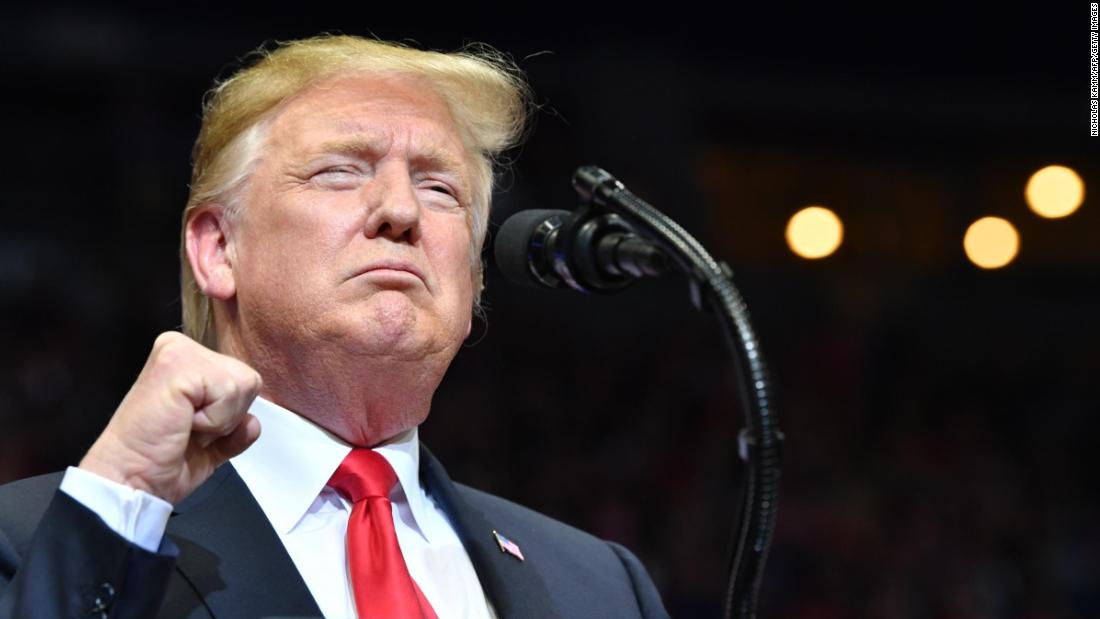
Here's what we looked at in our live fact check last night.
The Russian probe
Trump opened his rally in Michigan by describing the "incredible couple of weeks" America has seen recently. He cited the economy, the defeat of ISIS in Syria and the end of special counsel Robert Mueller's investigation into Russian interference in the 2016 election.
"After three years of lies, smears and slander, the Russia hoax is finally dead" Trump said. "The collusion delusion is over."
He said Mueller "found no collusion and no obstruction" and said the report exonerated him.
Facts first: The President is correct on the question of collusion, but he is wrong to suggest that Mueller found "no obstruction."
We fact checked this same claim from Trump on Tuesday. Here's what we found:
Trump is correct that Attorney General William Barr's letter to Congress said Mueller's team of investigators "did not establish that members of the Trump Campaign conspired or coordinated with the Russian government in its election interference activities."
However, Trump falsely claimed that the report said there was no obstruction. Barr's letter, directly quoting the Mueller report, clearly states that "while this report does not conclude that the President committed a crime, it also does not exonerate him" on questions of obstruction.
Mueller said he had thoroughly investigated the obstruction question, though he didn't interview Trump in person and the written questions he submitted to the President did not address obstruction.
Barr and Rosenstein chose not to prosecute. They decided that they couldn't press a case against Trump because they determined his actions did not meet the standards for prosecuting such a case.
While discussing the US economy, Trump said that Russia will not be happy about the United States becoming the No. 1 oil and gas producer in the world.
"The United States -- people don't even believe this, it all happened very recently -- is now the No. 1 oil and gas producer in the world," Trump said. "And by the way, Russia's not happy about that, but they're fine. They're doing just fine, but they're not happy about that."
But is the US actually No. 1?
Facts first: That's true, but context is needed.
Here's what we've found:
The US became the world's largest crude oil producer in August 2018, when it surpassed Russia for the first time since 1999 in terms of total daily crude production, according to the US Energy Information Administration. Earlier in the year, the US surpassed Saudi Arabia's crude oil production for the first time since 1973. It has been the largest producer of natural gas since 2011.
The rise in US oil and gas production is due in large part to advances in fracking technology that allowed drillers to access reserves socked away in shale formations buried deep underground. Production dipped in 2015 and 2016 as a result of overproduction and a collapse in oil prices, but recovered quickly once supply stabilized and prices increased, just as Trump was coming into office.
The Trump administration often touts its moves to relax Obama-era rules on oil and gas production, such as one restricting the flaring of methane from fracking sites. He has also opened public lands to more drilling. It's unclear though, given the decade of increased energy production in the US, how much of an impact any of those moves have had.
"We are building that wall," Trump told his supporters, followed by chants of "build the wall!" from the crowd. He continued by praising the "renovation" of parts of the border wall.
So what progress has been made on Trump's wall?
Facts First: There have been repairs and replacement of fencing and border security along parts of the border, but construction of new border fencing has not yet started.
In fact, we fact-checked a similar claim on the wall on Thursday.
Here's what we found:
So far, only repairs and replacements of barriers along the border have taken place. In mid-March, Customs and Border Patrol told CNN that "approximately 38 of 40 miles of wall in place of outdated designs in San Diego and El Centro, California, Santa Teresa, New Mexico and El Paso, Texas" using fiscal year 2017 funds.
(However, some of the replacement fencing has "replaced" vehicle barriers, not old fencing or wall. So, one could do a little mental gymnastics and refer to this as "new" fencing -- but it's not creating a new barrier where none previously existed.)
As the agency told CNN earlier this month, "the first new wall project, where no barrier currently exists, is anticipated to start in April in Hidalgo County of the Rio Grande Valley Sector."
On Monday, the Pentagon notified Congress of a $1 billion transfer for new wall construction and other border security measures. According to a letter from acting Secretary of Defense Patrick Shanahan to Secretary of Homeland Security Kirstjen Nielsen, this money will go toward building 57 miles of fencing in two areas of the border in Arizona and Texas. According to an official from the Department of Defense, construction on these sites might begin in late May.
This $1 billion is just the beginning of the $8.1 billion Trump's administration pointed to when looking at where it could transfer money for the wall -- which doesn't include additional funds Homeland Security could use or the $1.375 billion from the spending bill passed in February for 55 miles of new "barriers" in the Rio Grande Valley.
No comments:
Post a Comment